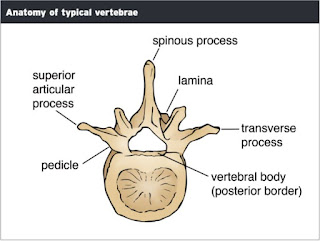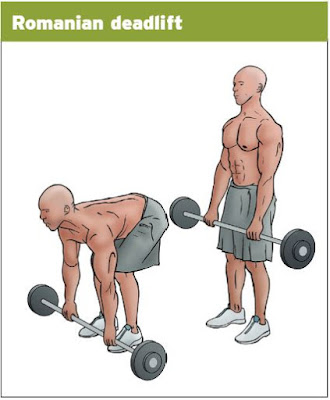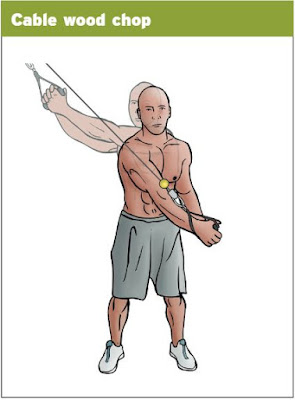Transverse process fractures are an uncommon type of sports injury reported in athletes. It commonly develops after direct contact injuries and/or due to a strong forceful contraction of the quadratus lumborum muscle when the trunk is in a position of side flexion.
Anatomy
Every vertebra of the spine is shaped with a pair of bony protrusions, wing-like in appearance, from each side, best referred to as the transverse processes, which function as an insertion point for muscles and ligaments. The transverse processes can be found along the vertebrae of the three distinct areas of the spine: the cervical vertebrae; the thoracic vertebrae; and the lumbar vertebrae. Each transverse process functions minimally different in each region of the spine.
Within the cervical spine, the transverse processes function as points of attachment for a variety of muscles surrounding the region, such as the suboccipital muscles, the scalenes and the levator scapulae as well as several ligaments which connect to these to help support the spine. The transverse processes located within the cervical spine are unique from the others in which they contain small holes to provide the passing of the vertebral arteries that extend from the subclavian artery to the brain, granting protection to this fundamental artery.
Along the thoracic spine, the unique function of the transverse process is to provide a point of attachment for the ribs through the structure known as the costotransverse joint. These articulations are essential towards the function of the ribs during breathing and movement.
In the lumbar spine, the transverse processes function as a base for the attachment of many of the trunk muscles which surround it, such as the quadratus lumborum, the middle layer of the thoracolumbar fascia, which is an indirect attachment point for the internal oblique and the transverse abdominus, the psoas major and the longissimus thoracis. Because many muscles insert onto these specific transverse process, the length and shape of these is much bigger than those found along the cervical and thoracic spine.
Small ligaments and proprioceptive muscles known as the intertransversi and the rotatores can be found between each transverse process, functioning as minor position sensors which allow the muscles to feel sensation during the movements of the spine. As a matter of fact, alterations which only occur during puberty may create abnormalities associated with the size and shape of these and fractures along these may occur in teenagers and young adults.
Mechanism of Injury
The transverse processes can become fractured through direct trauma or injury from contact sports or due to direct impact from falls off heights or from motorcycles. Automobile accidents can also cause injury to these important structures. In addition, because damage to the transverse processes usually involve high velocity forces, surrounding organs may also be affected. Also, depending on the extent of trauma, multiple transverse processes can be fractured at the same time. Furthermore, a muscle avulsion where it pulls off the transverse process can occur during a muscle contraction while in a forward bend, rotating posture or with strong lateral flexion movements, for instance, during rugby, MMA and judo. Finally, repetitive microtrauma as a result of constant and repetitive motions in certain sports and physical activities may also cause fractures, for example, as with cricket fast bowlers.
The three most common mechanisms of injury recorded with professional elite level rugby athletes included: direct impact from a knee, which causes fractures to the L2 and L3 transverse processes found in the lumbar spine, without causing other forms of injury; a strong blow to the upper chest/arm area from the side, which generally causes a player to contract their muscles, including the quadratus lumborum, resulting in an avulsion to the L3 transverse processes of the lumbar spine; and last, an individual falling heavily onto their side and landing on another player, was described to cause fractures to the L2 transverse processes of the lumbar spine as well as the 11th and 12th ribs on the same side.
Symptoms of Spinal Transverse Fractures
An individual who has experienced a transverse process fracture commonly describes symptoms of back pain immediately after a direct blow or a contraction. The pain may usually manifest as a severe, deep and localized type of discomfort. They may also experience radiating pain traveling down their buttocks or thigh. The symptoms may overall be debilitating or impairing, greatly restricting mobility to the point where walking and contracting of the attaching muscles may be difficult for the individual or athlete. Intense muscle spasms may also occur. Because some of the transverse processes are located very near several important organs, such as the lungs, kidneys, spleen, or liver, when injury occurs, the athlete may also experience organ-related symptoms such as shortness of breath, blood in the urine and blood pressure complications.
Investigations
Simple X-rays utilizing an AP view can show a transverse process fracture, but, because X-rays are often insensitive to overlying bowel gases, the view may be obstructed and detecting a fracture may be challenging. CT scans are generally the preferred modality to diagnose injury in many cases. In this instance, CT scans help visualize small fractures which may otherwise be difficult to detect on X-ray.
Treatment
The treatment options available for transverse process fractures largely depends on the amount of damage it caused initially and whether there was any damage to the surrounding organs or among other sections of the spine. If the transverse processes fracture is isolated without any other type of fracture, the injury can be effectively managed conservatively. Researchers determined that in 48 percent of patients with transverse process fractures, they also presented abdominal organ injury. Research studies concluded that if an external or internal force is powerful enough to break one of these structures, in 50 percent of cases, it will also cause damage to an internal organ. Therefore, transverse process fractures should be treated carefully and effectively through suspicion or organ damage involvement.
Managing the symptoms of a transverse process fracture can be achieved through a gradual conservative process. The key functional criteria to ensure the athlete is capable of returning to play include: pain free movements in and out of bed and/or a chair; pain free walking; pain free running; pain free side plank for up to 30 seconds; pain free sprinting; pain free gym movements including the involvement of strong abdominal contractions, such as deadlifts and functional unilateral exercises like kettle bell swings; pain free change of direction; and pain free contact in sport or physical activity.
As for the rehabilitation process, individuals and athletes can simultaneously work on strengthening exercises while also working on return to running and light skill training. Once the athlete experiences initial pain free movements, the rehabilitation process can proceed to an increase in weight load, change of movement direction and more difficult exercises can be implemented into the original rehab regimen. Also, massages to the quadratus lumborum and erector spinae can be useful as well as the use of heat therapy to decrease the symptoms of muscle spasm and pain relief. Anti-inflammatory medications are sometimes recommended by healthcare professionals, however, as these are often only temporary solutions to the symptoms, their use should be delayed to ensure the healing process proceeds accordingly. Painkillers are often used for sleep but are generally not recommended.
The key strength exercises that will ensure the athlete gained enough strength to be able to return to their specific sport can also be used to measure the improvement progress of the injury. These include exercises directly directly utilize the attachment muscles such as the quadratus lumborum, erector spinae and obliques. These exercises are listed and can be performed as follows: the side plank, built slowly from short 10-second holds to longer 45-second and above holds;
the Romanian deadlifts, can be initiated using a bar while progressively adding weight. Approximately half the individual’s bodyweight for 10 repetitions is a standard benchmark;
and finally, cable wood chops, the athlete should perform 10 full pain free repetitions with a full range of movement. Due to the variety of pulley systems, choosing a target weight to perform this specific exercise can be difficult.
Ultimately, it’s important for an athlete to seek immediate medical attention if they experience any of the previously mentioned symptoms and if the presence of a transverse process fracture is suspected. Various qualified healthcare professionals, such as chiropractors and physical therapists, are specially trained to diagnose and treat similar injuries. A chiropractor may use an array of massage and mobilization therapies to help strengthen the surrounding muscles as well as improve the individual’s original mobility and flexibility. Through a chiropractic adjustments, chiropractors may also carefully realign a subluxated spine to further improve the individual’s symptoms, helping to decrease the amount of stress or pressure being applied against the spine. Furthermore, a chiropractor can recommend additional exercises from the ones mentioned above, accordingly set up for each individual’s injury. Before attempting any of the previously mentioned exercises, be sure to consult a medical professional to avoid further injury and speed up the rehabilitation process.
Transverse Process Fracture Overview
By Dr. Alex Jimenez









